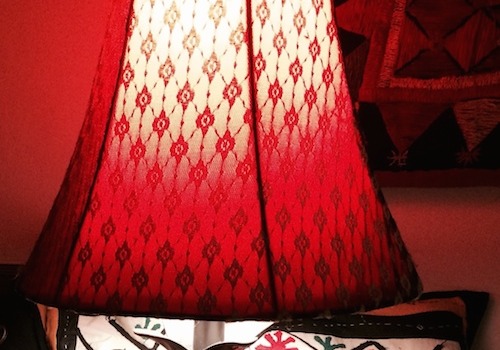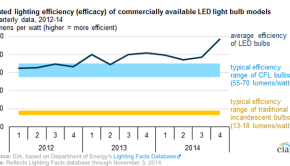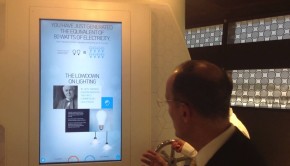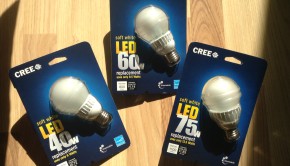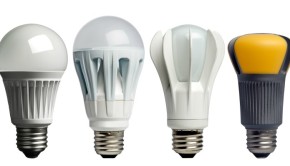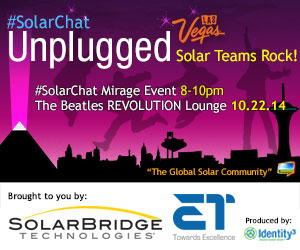Lush, Low Cost LED Light Bulbs From Cree Go Way Below $10
October 28th, 2014 by Tina Casey
The magical $10 price barrier for LED light bulbs was crashed last year and today one of the main crashers has just come out with a brand new edition that pushes their initial price down even lower. That would be North Carolina’s Cree, which has just informed us by email that the going rate for its standard 60-watt equivalent will be $7.97, not counting in-store discounts or promotions. Cree also shipped us a sample to try out and it arrived just in time for this review, so we gave it the acid test: our favorite reading lamp.
Soft, Warm Light From A Cold, Hard, Light Emitting Diode
For those of you who haven’t seen LED light bulbs in action yet, the idea of creating luminescence through radiative recombination may sound a little cold, so we put the bulb through its paces in the warmest-looking fixture of the house. It’s also one that gets direct use for reading electronic media and printed matter.
The image above is the lamp we use all night, every night, after working under unshaded fluorescent office lights all day, so a nice, soothing light is a priority in that particular fixture.
Our new Cree LED light bulb replaced a pretty decent CFL that gave off a fairly soft light, which was pleasant enough under the red lampshade. However, even to our relatively undiscerning eye the light from the new Cree was a few degrees softer and warmer.
If you already have CFLs at home but are a little put off by the squiggly shape that some of them sport, the Cree bulb also offers a return to the traditional styling of an incandescent bulb. It also reaches full brightness in an instant, and it has hum-free and buzz-free compatibility with most dimmers.
Also, if you are a klutz, keep in mind that the shell of the Cree bulb is now made from shatter-resistant plastic, not glass (our sister site greenbuildingelements.com can give you a rundown on other advantages of LED light bulbs).
The question is, is it worth tossing out a perfectly good CFL in favor of an LED, even at well under the $10 price point? That depends on your household budget, but one alternative to the CFL recycling bin would be to give them to a local civic organization, or perhaps use them to tempt an incandescent-hoarding neighbor into trying out a free energy-saving bulb.
Speaking of saving energy, here’s the lowdown on the new Cree LED light bulb according to the company’s specs.
At 82 percent less energy consumption than conventional light bulbs, The 60W Cree that we tested will save an average of $1.32 yearly when used for just three hours daily. All else being equal, your payback period would span just a few years, and for your $7.97 investment you get a lifetime savings of about $135.
Since the lifespan of the Cree bulb is estimated at almost 23 years (at three hours daily), you’re also going to save additional money on the replacement cost for conventional bulbs, which have a much shorter life.
For the record, Cree provided us with the 60W “Soft White” version of its new LED light bulb. The company also offers a “Daylight” version that goes for $8.97.
Coaxing Down The Cost Of LED Light Bulbs
LED technology is the bomb when it comes to energy efficiency, so the problem for introducing it into mainstream household lighting is the up-front cost.
One of the main obstacles is the high internal temperature at which the bulbs operate. Typically, LED light bulb manufacturers counter that with a “heat sink,” but Cree figure out a way to get around it.
We don’t have the press materials handy but an email from Cree provided us with the lowdown:
The new Cree LED bulbs replace expensive external heat dissipation with a new 4Flow Filament Design using cross-flow ventilation to cool the LED. By eliminating the heat sink entirely with this convection technology, Cree’s engineers have taken advantage of the simple principle that heat rises.
Any heat generated from the bulb will draw the cooler ambient air through the bulb to vent the heat into the ambient. Thermal equilibrium around the bulb is achieved and voila, the need for a heat sink is no more.
Aside from improving the efficiency of the bulb, that convection-based design saves a significant amount in manufacturing costs, which accounts for why Cree was able to lower its prices again after busting through that aforementioned $10 LED barrier last year (Cree’s three-way LED also provides a comparison).
Not for nothing, but we built this low cost LED light bulb! That’s right, Cree is one of the recipients of Energy Department grants aimed at bringing down the cost of ultra energy-efficient household and commercial lighting. That includes manufacturing costs as well as improving the efficiency of the technology itself.
Follow me on Twitter and Google+.
Keep up to date with all the hottest cleantech news by subscribing to our (free) cleantech newsletter, or keep an eye on sector-specific news by getting our (also free) solar energy newsletter, electric vehicle newsletter, or wind energy newsletter.
-
sal3
-
Steven F
-
-
Steven F
-
Kyle Field
-
hhl
-
Kyle Field
-
-
-
Kyle Field
-
Adrian
-
GCO
-
Adrian
-
GCO
-
djr417
-
-
-
-
-
spec9
-
David in Bushwick
-
BlackTalon53 .
-
Kyle Field
-
-
Jenny Sommer
-
Larmion
-
GCO
-
Larmion
-
spec9
-
GCO
-
Larmion
-
GCO
-
Jenny Sommer
-
-
-
-
Bob_Wallace
-
Larmion
-
dcard88
-
-
GCO
-
Bob_Wallace
-
GCO
-
Bob_Wallace
-
Offgridman
-
dcard88
-
-
-
spec9
-
Bob_Wallace
-
GCO
-
-
Jenny Sommer
-
-


